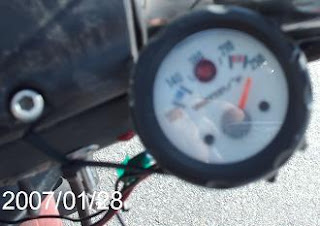941 is not 1000
 The 1000 mile day on the diesel was very close to being a complete success. In school, 94% would be an A-, not so here.
The 1000 mile day on the diesel was very close to being a complete success. In school, 94% would be an A-, not so here.
Things that worked.
Speed - very good. Until the end, the rolling average was above 72 mph.
The bike got smoother as the day went on. The vibration continues to go away. I think that was caused by the new engine. As the engine breaks in, it's gaining power losing vibration.
Things that need work.
The drive sprocket on the input shaft of the transmission wobbles. The assembly instructions stated to use red lock-tite when the sprocket went on the shaft. It appears that either the engineer (me) that decided this was ok for this application or the mechanic (me) who put it together made an error. I suspect I'll need a new mainshaft for the transmission and a new sprocket to put on it. Of course all the associated gaskets and bearings will also be needed.
 The radiator isn't quite large enough. At 70F, I can ride at 75, but I can't ride at 80. The radiator hoses are smaller than those designed for the engine. I think the restriction in the radiator is causing cavitation in the water pump.
The radiator isn't quite large enough. At 70F, I can ride at 75, but I can't ride at 80. The radiator hoses are smaller than those designed for the engine. I think the restriction in the radiator is causing cavitation in the water pump.
Electrical add-ons. The voltmeter quit working, the CB doesn't transmit. Minor items.
As a shakedown run, it was a success. But, more work is needed.
 John Ryan rode with me all day. We trade boredom on each other's rides. I counted laps when he rode the New York City 1000. John took the pictures today and tried to talk me into riding a Bun Burner Gold. If we had done that, we would be near Savannah, Georgia right now instead of back here in Virginia.
John Ryan rode with me all day. We trade boredom on each other's rides. I counted laps when he rode the New York City 1000. John took the pictures today and tried to talk me into riding a Bun Burner Gold. If we had done that, we would be near Savannah, Georgia right now instead of back here in Virginia.
 The 1000 mile day on the diesel was very close to being a complete success. In school, 94% would be an A-, not so here.
The 1000 mile day on the diesel was very close to being a complete success. In school, 94% would be an A-, not so here.Things that worked.
Speed - very good. Until the end, the rolling average was above 72 mph.
The bike got smoother as the day went on. The vibration continues to go away. I think that was caused by the new engine. As the engine breaks in, it's gaining power losing vibration.
Things that need work.
The drive sprocket on the input shaft of the transmission wobbles. The assembly instructions stated to use red lock-tite when the sprocket went on the shaft. It appears that either the engineer (me) that decided this was ok for this application or the mechanic (me) who put it together made an error. I suspect I'll need a new mainshaft for the transmission and a new sprocket to put on it. Of course all the associated gaskets and bearings will also be needed.
 The radiator isn't quite large enough. At 70F, I can ride at 75, but I can't ride at 80. The radiator hoses are smaller than those designed for the engine. I think the restriction in the radiator is causing cavitation in the water pump.
The radiator isn't quite large enough. At 70F, I can ride at 75, but I can't ride at 80. The radiator hoses are smaller than those designed for the engine. I think the restriction in the radiator is causing cavitation in the water pump.Electrical add-ons. The voltmeter quit working, the CB doesn't transmit. Minor items.
As a shakedown run, it was a success. But, more work is needed.
 John Ryan rode with me all day. We trade boredom on each other's rides. I counted laps when he rode the New York City 1000. John took the pictures today and tried to talk me into riding a Bun Burner Gold. If we had done that, we would be near Savannah, Georgia right now instead of back here in Virginia.
John Ryan rode with me all day. We trade boredom on each other's rides. I counted laps when he rode the New York City 1000. John took the pictures today and tried to talk me into riding a Bun Burner Gold. If we had done that, we would be near Savannah, Georgia right now instead of back here in Virginia.




